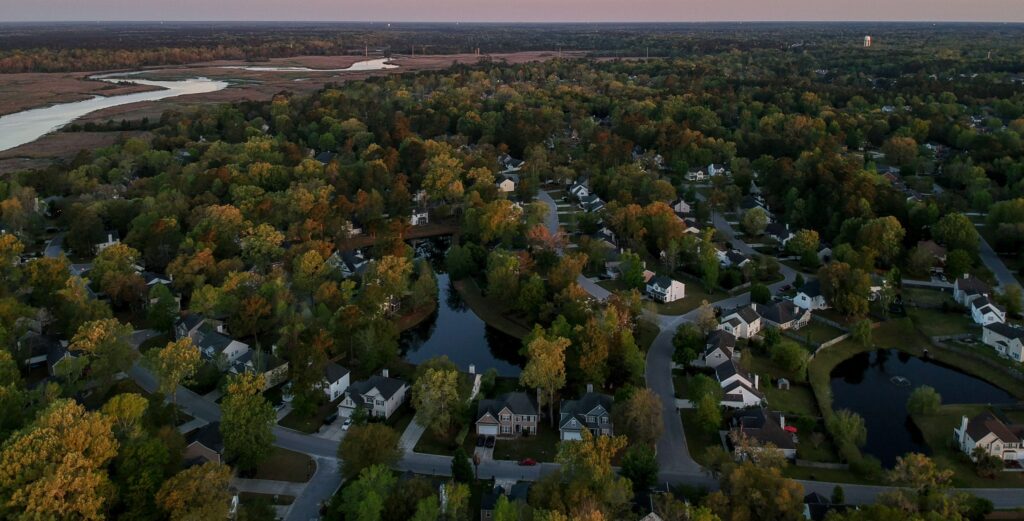February 22, 2021
—
First Street Foundation just released new research that quantifies the financial impact of flood risk for homeowners across the United States. In this post, we’re answering questions about the research and sharing our perspective on the topic.
What is First Street Foundation’s new research?
Last June, First Street Foundation released the flood risk assessment tool Flood Factor that, among other things, detailed flood risk for 142 million properties in the contiguous U.S. The Flood Factor launch, which AFC summarized, created a more robust and complete assessment of risk than traditional flood risk maps, synthesizing many types of flooding—including coastal, rainfall, riverine, and sea level rise. Now, First Street Foundation added dollar estimates of flood damage for individual residential homes to the tool, giving more direct insight into the financial cost of flood risk.
First Street Foundation calculated these damage estimates utilizing a statistic called Average Annual Loss (AAL), which is commonly used in the insurance industry to identify expected loss per year from flooding, averaged over many years. First Street Foundation derived their particular AAL estimates using their state-of-the-art flood model to estimate how often and how deep flood waters will be within a property. Then, by applying depth-damage curves, which relate to how much damage a certain depth of flooding will do to a property, the damage in dollars from flooding on an annual basis was estimated. The new dollar estimates are available via Flood Factor for every residential home (1–4 units) in the contiguous U.S. today and over the next 30 years.
What are the key findings?
- Today, over 4 million homes have substantial flood risk and face average annual financial losses from flooding. First Street Foundation finds that the expected annual loss in 2021 for these properties combined is more than $20 billion. Nearly one quarter of these 4 million homes are in Florida.
- Significant estimated financial losses exist in places where residents are less likely to be aware of their flood risk. Over half of these residential homes with substantial flood risk and average annual financial losses are outside of FEMA-designated Special Flood Hazard Areas (SFHA). Because their properties are outside the SFHA, these homeowners are not required to buy flood insurance and likely unaware of their risk. Even for properties that require flood insurance, such as properties with federally backed mortgages inside SFHA, the rate of holding flood insurance can be as low as 50%.
- Total expected annual losses from floods are projected to increase 61% by 2051. The data estimates that total annual expected losses will grow from $20 billion this year to over $32 billion—an increase of 61%—in 2051 because of higher seas, stronger storms, and more frequent flooding.
How should this data be used?
This data can raise awareness about the potential financial implications of flood risk. The data can be used to:
- Highlight the importance of taking action to reduce flood risk. This research encourages municipal-scale efforts to educate community members on the financial cost of flood risk, increase the purchase of flood insurance, and enroll in the Community Rating System.
- Underscore the importance of flood insurance affordability. This data demonstrates the burdensome true cost of flood risk, reinforcing strategies to ensure flood insurance is affordable for low-income populations.
- Estimate the benefits of flood resilience. The Flood Factor tool now allows a user to change the elevation of their structure and explore how that change will impact the expected losses from flooding. This feature can help property owners carefully consider flood resilience investments.
However, this data should not be used to:
- Predict exact flood damages at specific addresses. Average annual losses are estimates.
- Represent the full cost of flooding. Important unknowns not covered in the research factor into flooding costs, including overhead costs (e.g., the cost to relocate), risk reduction measures (e.g., stormwater parks), and losses that cannot be insured (e.g., loss of property value).
Why does this research matter?
This research has implications far beyond the 4 million homes with substantial flood risk and average annual financial losses.
If insurance pricing is adjusted to reflect the true distribution of flood risk, premiums will change. The research from First Street Foundation suggests major changes are needed for flood insurance premiums to reflect the true distribution of flood risk. FEMA, well aware of the broad underpricing of risk in existing flood insurance premiums, has been working on an initiative to update National Flood Insurance Program (NFIP) rates to more accurately reflect individual properties’ flood risk. This initiative, Risk Rating 2.0, is set to be formally released on October 1—policyholders will receive rolling renewal notices of potential increases starting as early as August 1. While we still lack all the details of Risk Rating 2.0, if FEMA’s methodology is similar to First Street Foundation’s, we could expect a more accurate portrayal of flood risk that may result in increased rates in high-risk places. For instance, for the over 4 million properties with substantial flood risk that face average annual financial losses from flooding, premiums would need to increase 4.5 times on average to cover today’s risk. However, FEMA confirmed that the 18% cap on increases to premiums for most current NFIP policyholders will remain in effect and ensure that homeowners’ premiums will not increase this drastically.
Affordability may become an issue for many households. We cannot predict precisely how NFIP pricing will change when Risk Rating 2.0 takes effect, but First Street Foundation’s model suggests it will bring a more accurate assessment of flood risk to the pricing structure. However, affordability will be a challenge for any insurance pricing approach that more accurately reflects flood risk. Should Risk Rating 2.0 raise the cost of flood insurance, as is expected, many people may be unable to afford the insurance, posing especially serious challenges for low-income households and households for which their primary asset is their home. FEMA does not currently have the authority to implement an affordability program nor a mandate to address affordability issues with Risk Rating 2.0. It’s still unclear how affordability will be addressed. Some cost guardrails, however, will remain in place, including caps on rate increases for most current policyholders.
Implications for renters, borrowers, and owners of units in multifamily buildings are still unclear. Since costs borne by property managers are often passed onto residents, the First Street research should prompt us to consider the financial impact of flooding for renters and people living in buildings with more than four units (as this research focused on residential buildings with 1–4 units). Additionally, we should use this research to reexamine how risk is quantified, managed, and disclosed in real estate financial markets. For instance, flood risk to Fannie Mae and Freddie Mac remains poorly understood, but once flood risk is internalized, how will it affect borrowers? Ultimately, it’s too early to tell the impact of more accurately pricing flood risk into insurance rates, especially with the additional complications of COVID-19, but we must start thinking about it and asking these questions.
This research marks a meaningful step toward linking flood risk to financial losses and democratizing access to both types of information. However, the data represents only the beginning of the important work. While the findings help reveal the true cost of flooding and sea level rise, we must now use this data to ensure flood protection is available for all who need it and not merely a privilege for those who can afford it.






